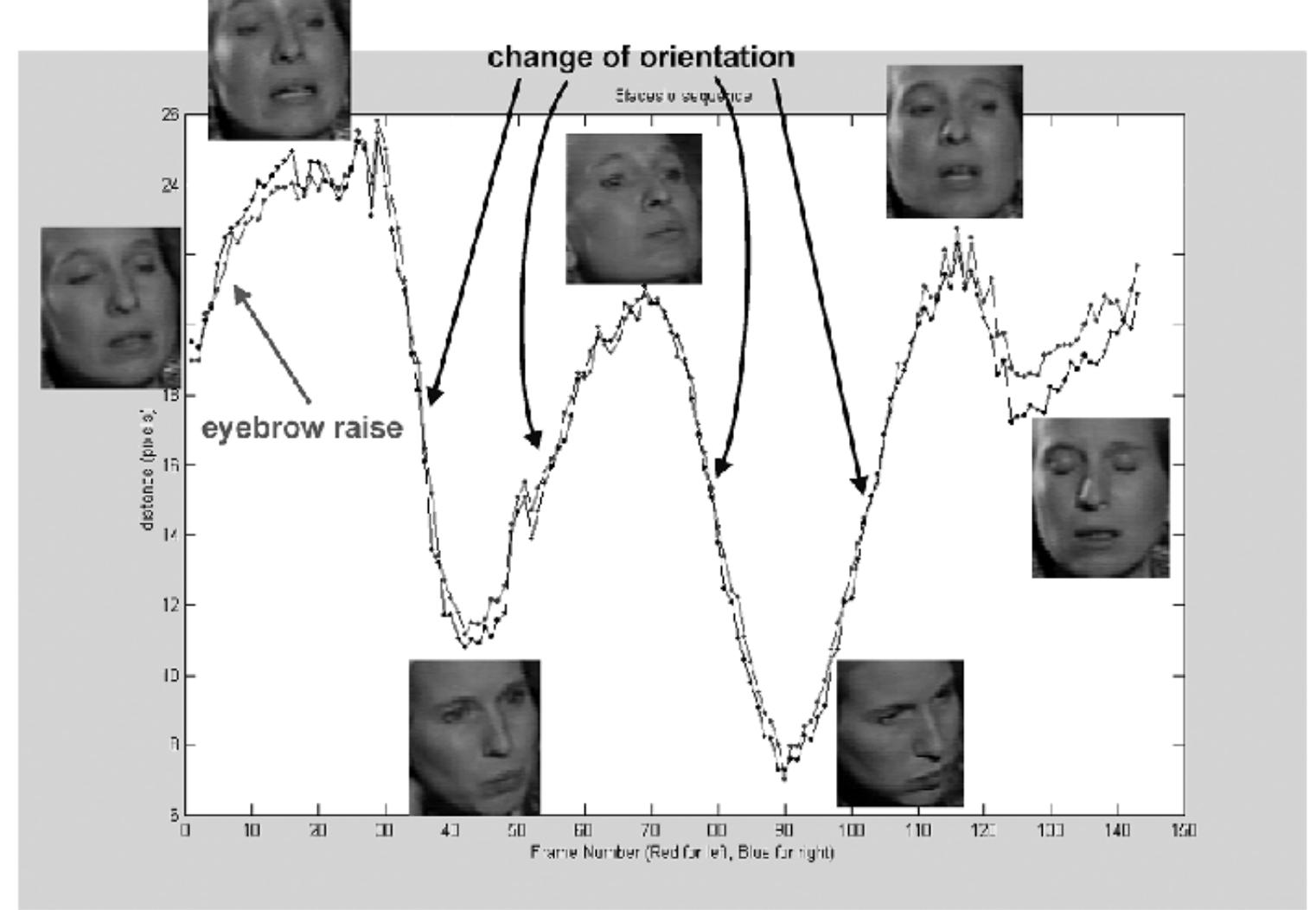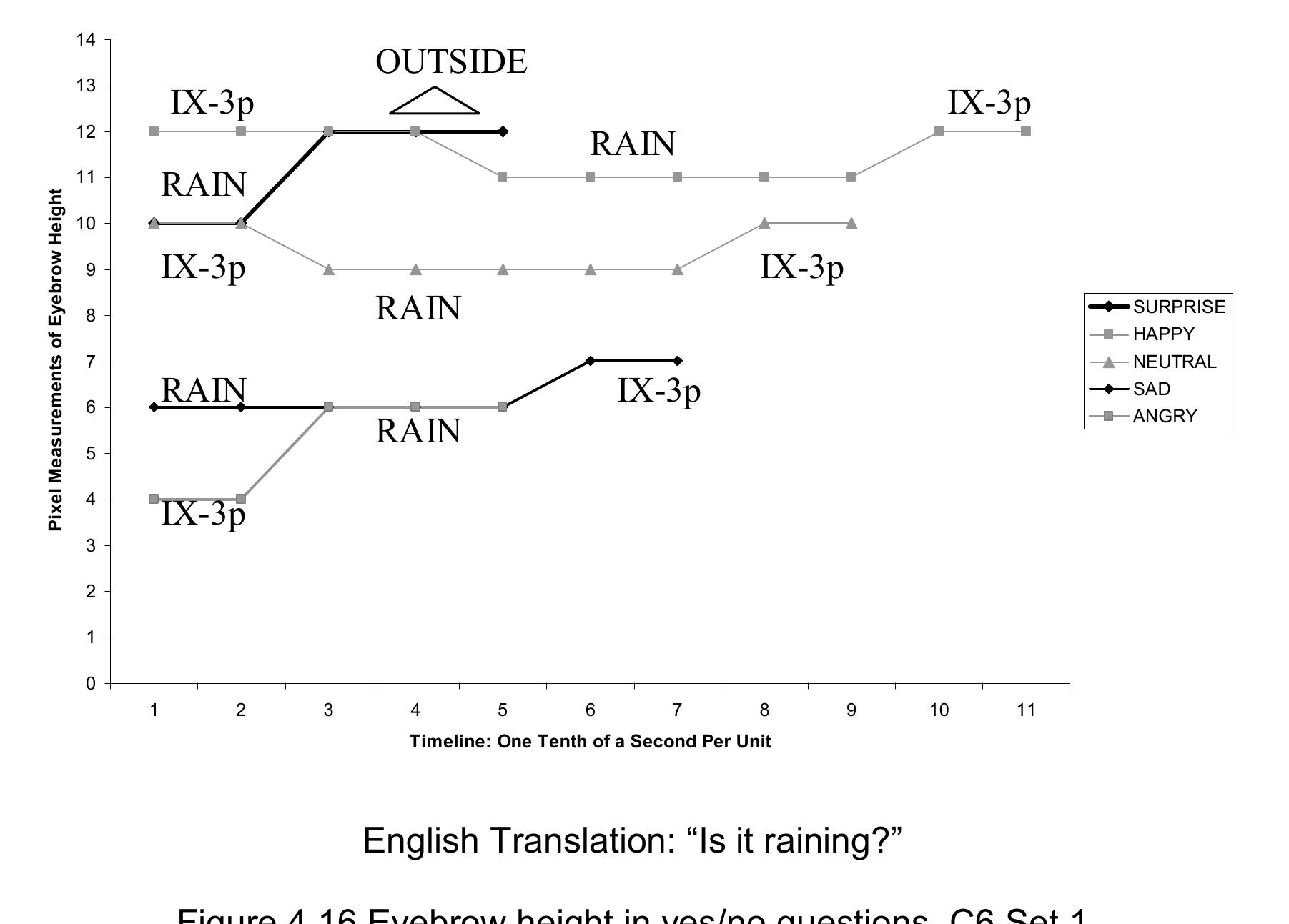Questions in American Sign Language: A quantitative analysis of raised and lowered eyebrows (The University of Texas at Arlington, 2008) (original) (raw)
Abstract
supervising professor, Jerold Edmondson, who gave encouragement, insight, and specific feedback over every part of this work. I am grateful for all your help and encouragement in my graduate career, and for starting me on the right path from the first laboratory phonology course, where I fell in love with experimental linguistics. Thank you to David Silva, who gave critical remarks to help polish the prose and make every paragraph follow a logical flow. I appreciate your attention to detail and your honest feedback in order to help me say what I intended to communicate. Thank you to Judy Kegl, our ASL researcher on the committee, who, despite many significant obstacles, took the time to give feedback and who encouraged me in many aspects of this work. Thanks to Laurel Stvan and Mark Ouellette, who also provided important feedback throughout the process, helping to shape this work. I also thank Ronnie Wilbur, who was not on my committee, yet still took me under her wing and gave me encouragement and guidance. I am grateful for your help and friendship. Finally, to my colleagues in the graduate school, especially Sarah Fauzi, Natalie Sears, Alicia Navarette, and Wenhua Jin, I say thank you for the friendships and encouragements through the years.
Figures (43)
Figure 1.1 (a) NOT-YET with tongue protrusion, and (b) LATE without the tongue movement. Image drawings are from consultants in this research. not well-formed, and in some cases creates an altogether different sign, such For instances such as figure 1.1, the nonmanual distinguishes minimal pairs, such as the example of (a) NOT-YET and (b) LATE. In NOT-YET, the
In Figure 1.3 the sign RECENT is overlaid with the mouth movement
Figure 1.4 shows how eyebrows fit into the greater linguistic framework Nonmanuals in ASL can be further divided between the upper body, in ASL for purposes such as signaling ends of phrases (e.g. Wilbur 1994b).
Aarons 1994 observes that it is possible for wh-marking to spread over
spoken language (Bellugi et al. 1989). involved, the left hemisphere was active, correlating with linguistic content in which contains a purely grammatical nonmanual marker with no emotion
on the internet. Figure 2.2 SignStream™ transcription portion from ASLLRP, Neidle 2001 application created to allow ASL digital transcriptions of both manual and This multi-level analysis allows all the observed information to be recorded and
label Lowered, as seen in figure 2.3, based on SignStream ™ conventions. Figure 2.3 Example of numeric representation based on eyebrow movement. partial listing, from Grossman and Kegl 2006 Each label of eyebrow height then received a number from 12 (highest)
Figure 2.4 Examples of eyebrow height (top two lines) and eye aperture changes (middle two lines), of two signers in a surprise statement, from Grossman and Kegl 2006.
Figure 2.5 Eyebrow levels of two signers for angry, quizzical, and wh-questions based on impressions of movement, from Grossman and Kegl 2006 The study also concluded that there are virtually no changes in eyebrow eye aperture decreased or vice versa. This pattern of similar eye aperture and
Figure 2.6 Graphical representation of (a) perception of the current debate and (b) a new approach to much of the contrasting information intonation, and syntax in ASL. The theoretical implication is charted in figure
Figure 2.7 Diagram of the five tone shapes of Central Thai (Standard as in Bangkok), generated from Praat. in Thai. numerals 1-5 (5 is high). To demonstrate, Figure 2.7 represents the five tones
Table 3.1 Stimulus Sentences in ASL Glosses and English Translation Table 3.1 above shows the three sentence sets included in the final familiar to the average individual. The sentence sets and set types are listed because in the modified script procedure consultants frequently replaced it with a repeated pronoun instead.
Figure 3.1 Sample Card Seen by Consultants Listing Emotion and Sentence- Type “Statement”, also in the same manner as Baker and Padden (1978). signed. The card simply listed the emotion name, and the word “Question” or
Figure 3.2 A surprise statement signed by one of the consultants, signing RAIN, with the card inserted behind and to the left of the signer. Seen in figure 3.2, the card was color coded to indicate the target
/ideo taping, seen in Figure 3.3 below. Figure 3.3 Facial markings to capture movement, Granstrom and House 2006 Granstrom and House 2006 used markers placed on the face during
Figure 3.5 Computer vision from Purdue University from the Active Appearance Model Face Plot to follow these faces during signing. One example is in Figure 3.5 below. eyebrow. The computer is trained to follow this
Figure 3.6 Computer Vision for recognition of American Sign Language, Purdue University their website, seen below in Figure 3.6.
Fig. |. Facial landmarks. SO immediately above eyebrow in mid- pupillary line, /O inferior skin fold below orbital rim in mid pupillary line, L point where nasal labial fold meets alar, M corner of mouth, Le lateral canthus, Mc medial canthus. NB The periocular region is very sensitive and therefore Le and Mc were visually identified. but not marked with adhesive dots
Figure 3.8 Screen Calipers website and image from Iconico.com results when re-visited later. After this initial training, | had to spend about 2
in Figure 3.7 from Clapham et al. (2006). Figure 3.9 Screen Calipers and facial landmarks example in Figure 3.9, with an image of the Screen Calipers tool near the image measurements are therefore crucial, and are described below in an enlarged
Figure 4.1 Eyebrow height for yes/no questions (Y/N), wh-questions (WH) and statements (DECL): Means across emotions for all 270 consultant sentences
Table 4.2 Percent Differential from Neutral Statement Table 4.2 starts with a neutral statement as a base line at 9.2 pixels from a neutral statement is listed for every emotion and sentence type.
Assumption of ASL Eyebrow Height: Emotions Vary Within Sentence Type Range Figure 4.2 Assumption of eyebrow height organization in ASL by sentence type and emotion types when emotion was added to the statements and questions.
Figure 4.3 Results from the data: Sentence types vary within emotional range Data of ASL MAX Eyebrow Height: Sentence Types Vary Within Emotional Range
Figure 4.5 Control comparison, Deaf vs. hearing non-signer eyebrow heights values for the HNS compared to means of all six Deaf signing consultants.
Figure 4.6 Control comparison: Hearing non-signer eyebrows do not correlate with pitch In figure 4.6, we see the results of an extraction | performed using Praat
Figure 4.7 C1 Eyebrow height in statements for Set 1: Declination effect
Figure 4.8 C6 Eyebrow height in statements for Set 1, Declination effect Figure 4.8 shows the same Set 1 statements as Figure 4.6 but with a
C1 Eyebrow Height in Statements for Set 3, TopictComment
Figure 4.10 C6 happy and C1 angry, wh-words initial and final for Set 1 demonstrate the lexical lowering over the wh-word in bracing form.
In figure 4.11, we see Set 2 for Consultant 3 with the same lexical
Figure 4.12 C6 eyebrow height in wh-questions sentence-final for Set 1 that are produced with only a sentence-final wh-word. With no sentence-initial
English Translation: “When did the red-headed girl go out?” carries a sentence-initial wh-word, seen in figure 4.13. Figure 4.13 C1 eyebrow height in wh-questions with a sentence-initial topic, Set 3 To compare topics across sentence types, for the same consultant C1, in
C6 Eyebrow Height in Wh-Questions, Wh-Word Sentence-final, Set 3 English Translation: “Where did the red-headed girl go out to/for what?” Figure 4.14 C6 eyebrow height in wh-questions with topics and no initial wh- word
C6 Eyebrow Height in Yes/No Questions, Set 1 always in sentence-final position. This lowering is seen in figure 4.16.
A final test is seen in figure 4.18. 4.18 Eyebrow height for “Why Did You Leave Without Paying!” in sentence- final position 4.6.2 Eyebrow Height in “Why Did You Leave Without Paying!”
Figure 4.19a-d (a) surprise wh-question, (b) neutral state, (c) surprise statement, (d) sad yes/no question
Difference of Least Squares Means for Maximum Pixel

Loading Preview
Sorry, preview is currently unavailable. You can download the paper by clicking the button above.










































